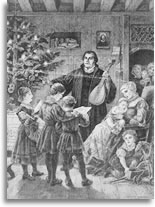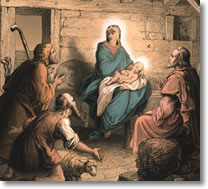by Rev. Raymond L. Hartwig
Already you can hear its whistle, catch a glimpse of its smoke just beyond the bend, above the snow-laden trees. Already there is much anticipation of its noisy arrival. You can feel the excitement. It’s the arrival of the Christmas Train, soon to make its annual stop at Christmas Magic Station.
Christmas train? Annual stop? Christmas magic?
I should explain.
 |
|
Shutterstock.com |
Year after year when our children were still at home and the time came to decorate our Christmas tree and frost the traditional sugar cookies, it also was time to fill our house with Christmas Magic, an album by Fred Waring and the Pennsylvanians. The album likened Christmas to a train loaded with all that we often associate with the season—snow, caroling, exchanging gifts, family gatherings, sleigh rides, bells, decorations, treats—all celebrated with an array of narrations and songs.
Aided by the enhancement of stereo, the sounds of the Christmas Train entered our living room from one side and, after unloading its Christmas freight, departed out the other. As it departed, with whistle blowing and steam engine chugging faster and faster, the narrator’s final words, when all else had been said and sung, said it all for our Christmas celebration as a family: “Christmas is Christ!”
Christmas Magic was one of our family’s favorite holiday treats, played over and over again. And it is still enjoyed over and over again. Several years ago, we provided Christmas Magic CDs to our grown-up children for their children to enjoy as they now prepare to celebrate Christmas in their homes.
All Aboard!
The “Christmas Train” never stays around long. In the album, it arrives, unloads, and departs—all in less than an hour. Too often our celebration of Christmas is like that. Each year we anticipate its advent around the proverbial bend and, before long, mark its departure for another year. And it won’t be staying long again this year. How important, then, to make the most of its stop at the station!
Unfortunately, it is easy to become preoccupied with all of the other freight that comes with the season. Add to that the many other Grinch-like goings-on in our lives, and we may never manage to approach the Christmas Train as we should, to take a good look at what it carries, to ponder it in our hearts.
One day when I was a small child, as my father and I crossed the railroad tracks across the street from our house in Shawano, Wis., we were invited by the conductor of a stalled freight train to climb into the caboose for a tour. It was a never-to-be-forgotten experience. In that caboose I remember some pretty rugged conditions for the men who rode the rails.
If we take the time to climb aboard the approaching Christmas Train, it will be memorable also. There we will find ruggedness all right, a rough-hewn stable, a lowly manger, infant Life destined for a rugged cross. But we will also find the Gift that will truly keep on giving, well beyond the final bend in our lives.
Fred Waring and his Pennsylvanians made it possible for our family to climb aboard the Christmas Train each year, to enjoy all of the trappings of the season, but also to have our attention called to that plain but amazing parcel being delivered by the season: “Christmas is Christ!” Fred and company called it Christmas Magic, to describe all that the Christmas Train brings with it. But it is far more miracle than magic, the miracle of God’s amazing grace.
Before Trains and CDs
 |
|
Illustration of Luther’s FamilyCourtesy Concordia Historical Institute |
Martin Luther wanted his family to climb aboard the Christmas Train also, except that he and his family predated trains by several centuries. Nor could he rely on the recorded music of others. So he produced and recorded his own “album,” a Christmas hymn complete with the Christmas story’s angel of glad tidings serving as the conductor. The conductor-angel invited Luther’s children and children of all ages to climb aboard, to see for themselves the Christmas miracle, “the joy of all the earth”:
“From heav’n above to earth I come
To bear good news to every home;
Glad tidings of great joy I bring,
Whereof I now will say and sing:
“To you this night is born a child
Of Mary, chosen virgin mild;
This little child of lowly birth
Shall be the joy of all the earth.
“This is the Christ, our God Most High,
Who hears your sad and bitter cry;
He will Himself your Savior be
From all your sins to set you free.
“He will on you the gifts bestow
Prepared by God for all below,
That in His kingdom, bright and fair,
You may with us His glory share.
“These are the signs that you shall mark:
The swaddling clothes and manger dark.
There you will find the infant laid
By whom the heav’ns and earth were made.”
Taking us on board, our conductor-angel tells us amazing things regarding the Child in the manger: “This is the Christ, our God Most High”! This Child “by whom the heav’ns and earth were made” will “Himself your Savior be!” Still, I don’t always take it to heart. Perhaps you don’t either. Needed is a good long look into that manger to experience what the great Venetian Renaissance painter Tintoretto experienced one day when he was moved to paint the ocean: He set up his easel and went to work, discarding canvas after canvas as he tried to capture what he was seeing. He finally threw it all aside and was heard to exclaim, “The ocean—it grows ever bigger!—no one can paint it!”
The angel in Luther’s hymn, echoing the words of the angel in Luke 2, paints with words very well, inviting us to step up and take a good look for ourselves while the Christmas Train is at our station this year. Luther’s hymn provides us that opportunity, and what we see grows ever bigger:
How glad we’ll be to find it so!
Then with the shepherds let us go
To see what God for us has done
In sending us His own dear Son.
Come here, my friends, lift up your eyes,
And see what in the manger lies.
Who is this child, so young and fair?
It is the Christ Child lying there.
Welcome to earth, O noble Guest,
Through whom the sinful world is blest!
You came to share my misery
That You might share Your joy with me.
Ah, Lord, though You created all,
How weak You are, so poor and small,
That You should choose to lay Your head
Where lowly cattle lately fed!
Were earth a thousand times as fair
And set with gold and jewels rare,
It would be far too poor and small
A cradle for the Lord of all.
Instead of soft and silken stuff
You have but hay and straw so rough
On which as King, so rich and great,
To be enthroned in royal state.
And so it pleases You to see
This simple truth revealed to me:
That worldly honor, wealth, and might
Are weak and worthless in Your sight.
May this hymn describe our careful look into the manger this year, such an important look, also for us who have known already for a long time what we will see there.
Yet, in so many ways, we are so much like the committee that met with an artist to commission him to paint a picture of a dying church, a request that he found intriguing. Weeks later he met with the committee again and unveiled his painting.
 |
|
Image of Nativity from a 19th century German Christmas postcard.Shutterstock.com |
They were surprised. He had painted a picture of a magnificent church, beautifully landscaped, with the doors wide open. Through the doors he had pictured a large congregation at worship, huge columns supporting a beautifully appointed interior. To the right of the doors he had painted an announcement board, full to overflowing with activities.
Finally, a spokesperson for the committee suggested that a mistake had been made. They had asked for a picture of a dying church, not one so obviously alive. “There has been no mistake,” said the artist, calling their attention to a small detail in his picture. To the left of the open doors, lost in some shadows, he had painted a small box identified with the word Missions. And over the slot in the top of the box he had painted a cobweb. “There,” he said, “is your dying church.”
Cobwebs happen, not only to mission boxes but human-care boxes, forgive-one-another boxes, all such boxes. When this happens, it requires more than a mere dusting with some sort of pledge to do better. It requires a long careful look into the manger (and beyond it to the cross and empty tomb), a look like that of mother Mary, who “kept all these things and pondered them in her heart.” It is that kind of look that dusts off the boxes and returns them to front and center in our lives.
The Greatest of Blessings
No one understood better than Martin Luther the importance of that meaningful look into the manger. Even he struggled to stay focused upon the grace of God. It was for this greatest of blessings that he prayed, even as he taught his children to pray in the final stanzas of his hymn:
Ah, dearest Jesus, holy Child,
Prepare a bed, soft, undefiled,
A quiet chamber set apart
For You to dwell within my heart.
My heart for very joy must leap;
My lips no more can silence keep.
I, too, must sing with joyful tongue
That sweetest ancient cradlesong:
Glory to God in highest heav’n,
Who unto us His Son has giv’n!
While angels sing with pious mirth
A glad new year to all the earth.
We, too, can do no better this Christmas season than to respond to the invitation to come aboard the Christmas Train as it makes its stop at our station, to take a good, long look to see what God Almighty is delivering, nothing less than His own Son. Perhaps the words of Luther’s hymn will help us to take that good, long look.
—
About the Author: Rev. Raymond L. Hartwig is secretary of The Lutheran Church—Missouri Synod.





